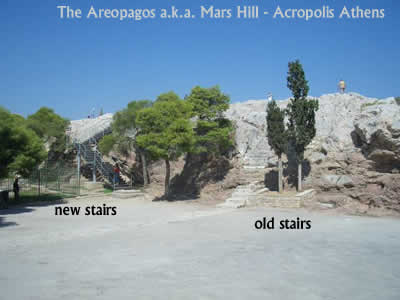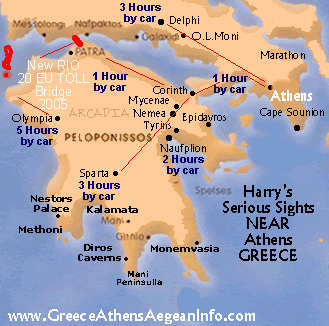 The Areopagos, meaning either ‘Hill of Ares’ or ‘Hill of the Curses’, is a worn rock outcrop just to the west of the Acropolis. The climb to the summit (access free) is rewarded with a beautiful view of the ancient Agora and day or night an anachronistic and peaceful view of the city of Athens.
The Areopagos, meaning either ‘Hill of Ares’ or ‘Hill of the Curses’, is a worn rock outcrop just to the west of the Acropolis. The climb to the summit (access free) is rewarded with a beautiful view of the ancient Agora and day or night an anachronistic and peaceful view of the city of Athens.
The lack of visible archaeological remains is compensated for by the many legends and stories that are associated with the Areopagos. Ancient Athenians believed that the war god Ares was tried here for the killing of Halirrhothios, son of Poseidon. (Ares was acquitted after pleading that he had merely saved his daughter Alkippe from being raped by Halirrhothios.) Aeschylus, in his play The Furies (458 BC) situates the trial of Orestes for the murder of his mother Klytemnestra on the Areopagos. Some huge boulders down the path on the East side of the Areopagos may the collapsed roof of the Cave of the Furies, where those acquitted of murder would bring sacrifice. The precinct of this cave also offered asylum to murderers and run-away slaves and was said to contain the tomb of the legendary Oedipus.
 From the 7th century BC the Areopagos was the seat of the Council of Elders and supreme court of Athens. Initially, this Council, composed of retired magistrates, constituted the most important political body of Athens. In the course of the late Archaic and Classical periods the power of the Areopagos, which was considered very conservative, was curtailed and its main function then became that of homicide court.
From the 7th century BC the Areopagos was the seat of the Council of Elders and supreme court of Athens. Initially, this Council, composed of retired magistrates, constituted the most important political body of Athens. In the course of the late Archaic and Classical periods the power of the Areopagos, which was considered very conservative, was curtailed and its main function then became that of homicide court.
In 51/52 AD the Apostle Paul addressed the council at the Areopagos (Bible, Acts 17, 22-34) and converted one of its members, Dionysios, who then became known as ‘the Areopagite’. Saint Paul’s “spirit was stirred within him when he saw the city full of statues of the ancient gods; … standing in the midst of the Areopagos he said, ‘Men of Athens, I find you in all things excessively daimon-fearing.’” Lower down the north slope, beyond the boulders of the Cave of Furies, are the remains of a 16th century AD church dedicated to Dionysios the Areopagite.
The path to the Cave of Furies and the church, starting at the east side of the Areopagos, leads further down the pleasantly wooded slope to the Agora and Plaka.
Access: free. Steps and rocks VERY slippery ascending and descending so be careful! They built a stairway on the left of the old steps so its only dangerous on the hill itself!

Athens,
Cape Sounion, Ancient Corinth, Delphi & Ossios Lukas, Drama, Florina, Greneva, Chalkidiki, Imathia, Kastoria, Kavala, Kozani, Meteora, Mt. Athos, Mycenaea, Naufplion, Olympia, Pella and Vergina, Phillipi & Kavala, Dion & Mt Olympus, Sparta & Mystras, The Mani and Monemvasia, Thessaloniki,
READ TESTIMONIALS
E-mail for prices and availibility